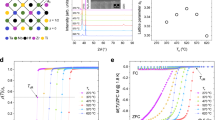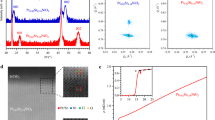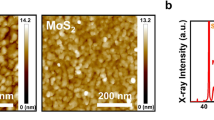Abstract
A LOWsurface resistance,Rs, is the key to successful development of radio-frequency and microwave applications of high-temperature superconductors. Here we report the Rs of YBa2Cu3Ox thick films on yttria-stabilized zirconia substrates at frequencies up to 50 GHz. Films processed below the peritectic temperature are fine grained, have Rs similar to bulk YBa2Cu3Or, generally have low critical current density (Jc) and exhibit little preferred orientation of crystallographic axes. Films processed above the peritectic temperature exhibit preferred orientation in large spherulitic grains, have higher Jc and far lower Rs. For these films the crossover frequency at which Rs equals that of copper is 50 GHz, a factor of two higher than the best bulk material or thick film yet reported and only a factor of ∼4 lower than high-quality thin films. At the frequencies used for mobile communications (900 MHz and 1.8 GHz), the superconductor losses would be two orders of magnitude lower than those of normal metals. The particular advantages of the thick-film route are the speed and low cost of the process, and the ability to apply the films on curved surfaces and on large areas, the largest so far being >200 cm2.
This is a preview of subscription content, access via your institution
Access options
Subscribe to this journal
Receive 51 print issues and online access
$199.00 per year
only $3.90 per issue
Buy this article
- Purchase on Springer Link
- Instant access to full article PDF
Prices may be subject to local taxes which are calculated during checkout
Similar content being viewed by others
References
Tinkham, M. Introduction to Superconductivity (McGraw-Hill, New York, 1975).
Muller, G. Proc. Conf. 4th Workshop on Superconductivity KEK Report 89-21 (ed. Kojima, Y.) 267 (1990).
Portis, A. M., Cooke, D. W. & Piel, H. Physica C 162–164, 1547–1548 (1989).
Hein, M. et al. Physica C 162–164, 111–112 (1989).
Hein, M. et al. J. appl. Phys. 66(12), 5940–5943 (1989).
Hein, M. et al. J. Superconductivity, 3(3), 323–329 (1990).
Button, T. W. et al. IEEE Trans. Magnetics (in the press).
Jin, S. et al. Phys. Rev. B 37, 7850–7853 (1988).
Alford, N. McN. et al. J. appl. Phys. 66, 5930–5934 (1989).
Murakami, M., Morita, M., Doi, K. & Miyamoto, K. Jap. J. appl. Phys. 28, 1189–1194 (1989).
Alford, M. McN. et al. IEEE Trans. Magnetics (in the press).
Ishii, O., Konaka, T., Sato, M. & Koshimoto, Y. Jap. J. appl. Phys. 29(7), L1075–L1078 (1990).
Smith, P. A., Davis, L. E., Alford, N. McN. & Button, T. W. Electronics Lett. 26(18), 1486–1487 (1990).
Author information
Authors and Affiliations
Rights and permissions
About this article
Cite this article
Alford, N., Button, T., Adams, M. et al. Low surface resistance in YBa2Cu3Ox melt-processed thick films. Nature 349, 680–683 (1991). https://doi.org/10.1038/349680a0
Received:
Accepted:
Issue Date:
DOI: https://doi.org/10.1038/349680a0
This article is cited by
-
Ba2ErNbO6: A new perovskite ceramic substrate for Bi(2223) superconducting thick films (T c(0) = 110 K)
Bulletin of Materials Science (2005)
-
Low Loss Sintered Dielectric Resonators with HTS Thick Films
Journal of Superconductivity (1997)
-
Weak-link behavior in superconducting thick films
Journal of Superconductivity (1995)
-
Preparation of oriented thick HTSC films by cryoelectrophoretic technique
Il Nuovo Cimento D (1994)
-
Microwave power-induced flux penetration and loss in high-temperature superconductors
Journal of Superconductivity (1992)
Comments
By submitting a comment you agree to abide by our Terms and Community Guidelines. If you find something abusive or that does not comply with our terms or guidelines please flag it as inappropriate.



